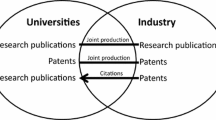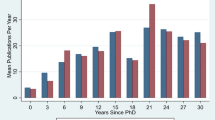Abstract
Stanford University has been ranked as the World’s Most Innovative University for the fourth year in a row according to the latest Reuters ranking (2018) [26].
You have full access to this open access chapter, Download chapter PDF
Similar content being viewed by others
3.1 Introduction to Ranking
Stanford University has been ranked as the World’s Most Innovative University for the fourth year in a row according to the latest Reuters ranking (2018) [26].
Examining the top 10 universities in 2018 ranking, a slight change can be seen from 2017 ranking. That is to say, eight of 2017 top 10 world universities remained in the top of the 2018 list. Meanwhile, Imperial College London and The University of North Carolina at Chapel Hill joined 2018 top 10 list for the first time. In contrast, University of Michigan and Korea Advanced Institute of Science and Technology (KAIST) have fallen out of the list [26].
Also, Massachusetts Institute of Technology (MIT) and Harvard University maintained their ranks of 2017; as they were ranked the second and third, respectively US universities occupied about half of 2018 World University Ranking list, where 46 US top innovative universities were listed with three less universities than 2017.
KU Leuven University in Belgium was ranked seventh, (two places back compared to the fifth rank achieved in 2017) but still remains on top of the innovative European universities in 2018. This is partially because the large number of highly important patents the university introduces, making it the best university outside the USA. Imperial College London occupied the eighth place in 2018 ranking, up from the 15th in 2017 list, making it the first in UK and the second in Europe. Meanwhile, among the world top 100 universities, European universities occupied 27 positions (26 of which were already in 2017 list), mostly in UK and Germany.
Apart from the USA and Europe, Asia occupied 23 positions mostly in South Korea and Japan. Korea Advanced Institute of Science and Technology (KAIST) ranked the 11th in the world (back from the sixth in 2017). However, it is still the Most Innovative Asian University preceding the Japanese universities in this regard.
New economic tigers and the fierce competition shown by Japan, South Korea, and China are to be taken into consideration. However, the ranking of the World’s Most Innovative Universities indicates that effective scientific research, which contributes to technological inventions and supports new industries and promising markets, is still conducted in the West not the East. The reason behind this is the fact that USA still largely funds scientific research, making Stanford University on top of the World’s Most Innovative Universities. This university, located in the heart of California's Silicon Valley, continues to play a major role in the development of the modern world of Internet connections. Graduates of Stanford have established the world's most renowned technology companies such as Google and Intel. The university continues to conduct new research and develop up-to-date technologies, which makes its research an important source of knowledge for researchers all over the world, noting the high percentage of citation recorded.
According to the ranking of the World’s Most Innovative universities, the top universities in this field are the most renowned and experienced universities of North America and Western Europe. Overall, American and Western European universities occupied 75 of the 100 places (48 for North American and 27 for Western European). The remaining 25 places are occupied by Asian universities, one of which is Japanese and two are South Korean, which introduce their programs in English. Among the top Asian universities is Korea Advanced Institute of Science and Technology (KAIST), established in 1971 by the Korean government on the model of US engineering faculties, and funded with a loan worth millions of dollars by the US Agency for International Development. On the other hand, none of the universities in Africa, South America, Oceania, or Arab countries, have been ranked in the innovative universities list yet.
It should be noted that the ranking of universities according to the ten criteria of innovation does not reflect the innovative efforts exerted by the researchers of a given department, faculty, or research center in a university. The ranking is based on the measurement of innovation at the university level as a whole, which means that an innovative department may exist in a particular university, but the university as a whole may not be included or listed at the end of the ranking list. This, of course, does not underestimate the efforts of such an innovative research center, which could serve as an effective source of modern science and technology.
3.2 Table of the World’s Most Innovative Universities
Table 3.1 shows the World’s Most Innovative Universities in 2018 [26]. This is the most recent rankings when this book was composed. In order to unify with the rankings of Asia-Pacific’s ranking table, Table 3.1 stopped at 75 most innovative universities.
From Table 3.1, it is clear that the highest number of the World's Most Innovative Universities in 2018 is in the USA. In Table 3.2, the numbers of the World’s Most Innovative Universities in 2017 and 2018 in the different countries are given for comparison.
Author information
Authors and Affiliations
Rights and permissions
Open Access This chapter is licensed under the terms of the Creative Commons Attribution 4.0 International License (http://creativecommons.org/licenses/by/4.0/), which permits use, sharing, adaptation, distribution and reproduction in any medium or format, as long as you give appropriate credit to the original author(s) and the source, provide a link to the Creative Commons license and indicate if changes were made.
The images or other third party material in this chapter are included in the chapter's Creative Commons license, unless indicated otherwise in a credit line to the material. If material is not included in the chapter's Creative Commons license and your intended use is not permitted by statutory regulation or exceeds the permitted use, you will need to obtain permission directly from the copyright holder.
Copyright information
© 2021 The Author(s)
About this chapter
Cite this chapter
Al-Youbi, A.O., Zahed, A.H.M., Nahas, M.N., Hegazy, A.A. (2021). The World’s Most Innovative Universities. In: The Leading World’s Most Innovative Universities. Springer, Cham. https://doi.org/10.1007/978-3-030-59694-1_3
Download citation
DOI: https://doi.org/10.1007/978-3-030-59694-1_3
Published:
Publisher Name: Springer, Cham
Print ISBN: 978-3-030-59693-4
Online ISBN: 978-3-030-59694-1
eBook Packages: EducationEducation (R0)




